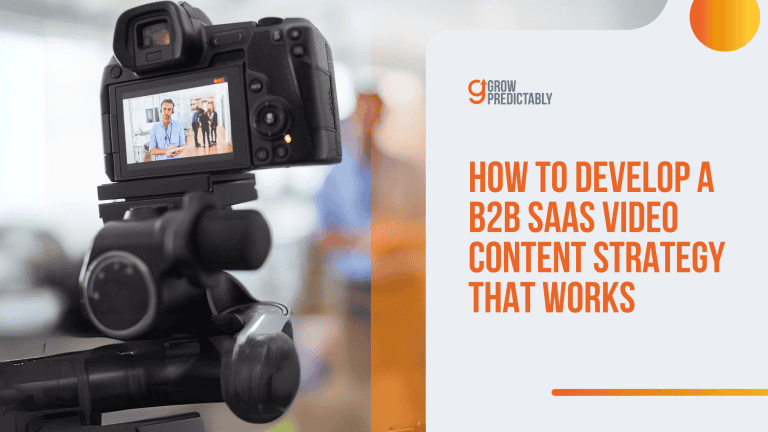6 Ways to Maximize SaaS Video Marketing in 2025
Are your SaaS marketing efforts falling flat?
Struggling to convert visitors into loyal customers?
Wondering how to make your brand more relatable and engaging?
Videos—do not overlook the power of videos in marketing!
Did you know that incorporating videos in landing pages alone can boost your conversion rates by up to 80%? (Source)
Understanding and mastering SaaS video marketing can transform your approach, making your brand more engaging and your marketing efforts more effective.
Imagine turning more leads into customers and significantly boosting your ROI through fun short clips.
Keep reading to unlock the secrets of SaaS video marketing and take your business to the next level.
Dive in to discover proven strategies and tips that can revolutionize your marketing game.
- Videos can boost your conversion rates by up to 80%, making them a powerful tool in your marketing strategy.
- Plan your video content by understanding your goals and target audience to ensure your videos address the right pain points.
- Scriptwriting and storyboarding help keep your video focused and engaging, preventing confusion and boredom for the audience.
- High-quality production, including good lighting and clear audio, makes your videos look professional and more appealing.
- Use strong calls to action (CTAs) like “Start Your Free Trial Today” to guide viewers on what to do next and increase conversions.
What is SaaS Video Marketing?
SaaS video marketing uses videos to promote and explain Software as a Service (SaaS) products.
Video marketing is a strategy where businesses can showcase their software’s features, benefits, and value through engaging visual content.
Through videos, SaaS businesses can effectively communicate their message in the wild digital market and convert potential customers into paying ones.
Videos are powerful tools, and they allow you to present your brand in a personal, relatable, and memorable way that resonates with your target audience.
Today, where attention spans are short and competition is fierce, video marketing can make all the difference when leveraged strategically.
Using video in SaaS marketing has several key benefits:
- Simplifies Complex Concepts: Videos make it easier to explain how your software works. They break down complicated features into simple, visual steps that anyone can follow.
- Boosts Engagement: People are more likely to watch a short video than read a long article. Videos grab attention quickly and keep viewers engaged.
- Increases Conversion Rates: Good videos can convert viewers into customers. They show real-life applications of your software, helping potential users see its value.
- Improves SEO: Search engines love video content. Adding videos to your website can help you rank higher in search results, driving more organic traffic.
- Builds Trust: Videos put a face to your brand. Seeing real people talk about your product builds trust and makes your brand more relatable.
- Enhances Retention: People remember information better when they see it in a video. This means they are more likely to remember your product and its features.
SaaS video marketing is an effective way to communicate your product’s value, boost engagement, and drive conversions.
6 Ways to Create Effective SaaS Marketing Videos
Are you ready to elevate your SaaS video marketing strategy with powerful, engaging videos?
In this section, we’ll guide you through seven actionable tips to create compelling SaaS marketing videos that captivate your audience, simplify complex ideas, and drive impressive conversion rates.

Let’s dive in and transform your video marketing approach with this step-by-step SaaS video marketing guide!
1. Plan your video content
To create effective marketing videos for your SaaS business, you need to know your goals and who you’re talking to first.
You have to decide what your video marketing objectives are and what you want your video to achieve.
Is it to get more sign-ups, explain a feature, or boost brand awareness?
You must also think about your target audience. Who are they? What problems do they have that your SaaS can solve? Knowing this helps you tailor your message to their needs.
Without these, your videos could end up being too generic or not addressing the right pain points.
This means wasted time and resources and less engagement from potential customers.
To help you plan your next SaaS videos, try answering these questions as part of your video marketing strategy:
- What is the main purpose of this video?
- Who is the ideal viewer for this video?
- What problem does our software solve for them?
- How familiar is our audience with our product?
- What action do we want viewers to take after watching the video?
- What key message do we need to convey?
- What tone and style will resonate most with our target audience?
- How does this video fit into our overall marketing strategy?
- What platforms will we use to distribute this video?
- What metrics will we use to measure the video’s success?
These questions help you focus your efforts and create SaaS videos that connect with your audience.
Planning my video content got easier once I started using a customer avatar and a content calendar.
Customer avatars helped me stay consistent with who I’m targeting with my SaaS marketing videos. Because I have a detailed understanding of who they are, I knew exactly how to address them and their pain points in my SaaS videos.
Content calendars also helped me organize topics, set deadlines, and track progress. By plotting everything out, I stayed consistent and avoided last-minute scrambles related to how I produce my, let’s say, SaaS explainer videos.
Content calendars and customer avatars are a great combination when planning your videos. They ensure you’re always on schedule and your SaaS video marketing always hits the target.
2. Scriptwriting and storyboarding
Starting with scriptwriting and storyboarding is a smart way to create marketing videos effectively. Why?
They lay the groundwork for a clear, engaging message.
If you produce explainer videos or demo videos, scriptwriting will help you plan what to say and how to say it.
It ensures your video covers all key points without rambling. This keeps viewers interested and makes complex ideas simple.
Storyboarding goes hand-in-hand with the script.
It’s like a visual plan for your video. You sketch out each scene to see how the video will flow. This helps you spot any problems before you start the video production.
If you skip this, your video might lack focus.
It could end up confusing or boring your audience. You might also miss important details or spend more time fixing issues during editing.
Storyboarding often comes easy after you come up with a script, since the visuals in each video is going to depend heavily on the business’s style or brand.
However, scriptwriting needs more system and order.
To do that, follow these tips:
- Start with a Clear Outline: Know what you want to cover. Write down the main points you need to hit. This keeps you focused and prevents you from going off-topic.
- Know Your Audience: Think about who will watch the video. What are their pain points? How does your software help them? Tailor your script to their needs and level of understanding.
- Keep It Simple: Use clear, straightforward language. Avoid technical jargon unless necessary. Your goal is to make your message easy to understand.
- Be Concise: Get to the point quickly. Aim for a script that is brief but informative. Long videos can lose viewers’ attention.
- Use a Conversational Tone: Write as if you’re talking to a friend. This makes your video more engaging and relatable.
- Include a Strong Call to Action: Tell viewers what you want them to do next. Whether it’s signing up for a free trial or visiting your website, make it clear and compelling.
- Read It Out Loud: Once you have a draft, read it aloud. This helps you catch awkward phrasing or overly long sentences.
- Revise and Edit: Don’t be afraid to make changes. Good scripts often go through several drafts before they’re perfect.
By following these tips, you’ll create a script that’s clear, engaging, and effective.
Using AI tools for scriptwriting and storyboarding made my marketing videos more efficient.
AI tools helped me write clear, engaging scripts fast. It also created voiceovers that sounded natural, saving me time. This allowed me to focus on the creative aspects without getting bogged down in details.
You can use AI to streamline your video production, too. Use tools like ChatGPT for your scripts and ElevenLabs to create quick human-sounding VOs in no time.
3. Production and Editing
Focusing on your video production and editing process is a smart way to ensure your videos look professional and grab attention.
Good production means using quality equipment and proper lighting. It makes your explainer videos or demo videos look clean and polished.
Clean audio is also key. Nobody wants to watch a video they can’t hear well.
For example, watching demo videos with bad audio quality can sometimes be counterproductive.
Instead of understanding the subject matter better, we become distracted by the bad audio, and we lose focus of the demo. Ring a bell?
Editing ties everything together, too. It lets you cut out mistakes, add effects, and keep the pace lively.
You can highlight important points with text or graphics, making your message more impactful.
Without these elements in your production process, your video might look amateurish.
Bad lighting or poor sound can turn viewers away fast.
Without editing, your video could drag on, losing viewers’ interest. It might also miss key details that make your product shine.
Before you start producing that video, ensure to check these things off your list first:
- High-Quality Camera: Invest in a good camera. It doesn’t have to be high-end, but it should capture clear, sharp images. A DSLR or a mirrorless camera can work well.
- Microphone: Clear audio is crucial. A good external microphone, like a shotgun mic or a Lavalier mic, will ensure your sound quality is top-notch.
- Lighting Kit: Proper lighting makes a big difference. Softbox lights or LED panels help eliminate shadows and make your video look professional.
- Tripod: A sturdy tripod keeps your shots steady. It’s essential for maintaining a professional look, especially during static shots.
- Background Setup: Choose a clean, uncluttered background. You might also consider a backdrop if you want a consistent look.
TIP: If you don’t know how to edit a marketing video, consider outsourcing. Use platforms like Upwork or Fiverr to find skilled video editors. Look for freelancers with good reviews and a solid portfolio. This way, you can get professional-quality videos without the learning curve.
4. Create engaging thumbnails
Even though this is a SaaS video marketing guide, we also do not want to forget how images can come into play—like thumbnails.
Think of thumbnails as your video’s cover. They are the first thing viewers see, and they play a big role in whether someone clicks or skips.
For example, when you’re on YouTube, SaaS explainer videos with good thumbnails can grab better attention than ones with poorly made thumbnails.
To ace this step, you must use clear images and bold text to highlight key points. Faces with expressions work well, too, because they connect with viewers.
Keep it simple but striking. Make sure it matches your video’s content to avoid misleading your audience.
Ignoring the quality of the thumbnails you use is very risky.
A dull or irrelevant thumbnail can make your video get overlooked. Even with great content, poor thumbnails mean fewer clicks.
This can lead to a drop in engagement and lower visibility on platforms like YouTube.
When designing a thumbnail, keep these best practices in mind:
- Use high-quality images that are clear and sharp.
- Include faces with expressive emotions to draw attention.
- Add bold, readable text that highlights key points.
- Keep the design simple but eye-catching.
- Ensure the thumbnail accurately represents the video content.
- Use contrasting colors to make elements stand out.
- Stick to a consistent style that matches your brand.
- Avoid clutter; focus on one main idea.
- Use branding elements like logos subtly.
- Test different thumbnails to see which gets more clicks.
5. Include a strong CTA
Including well-optimized calls-to-action (CTAs) is a smart way to boost the effectiveness of your SaaS marketing videos.
CTAs guide your audience on what to do next, whether it’s signing up for a free trial, downloading a resource, or subscribing to your newsletter.
A good CTA is clear and concise.
Use action-oriented language like “Sign Up Now” or “Get Started.” Place it strategically in the video, either at the end or during key moments.
Make it visually appealing with buttons or links that stand out.
Not using CTAs is also like leaving viewers hanging, unsure of the next step.
This can lead to lower engagement and fewer conversions. Even if your content is great, without direction, your audience might not take action.
By optimizing your CTAs, you turn passive viewers into active users.
It makes your videos more effective in achieving your business goals.
Here’s an example of how you can turn generic CTAs into compelling ones:
| Generic CTA | Optimized CTA | Why it works |
|---|---|---|
| Click Here | Start Your Free Trial Today | Clearly tells the viewer what they will get by clicking, encouraging immediate action. |
| Learn More | Discover How Our Software Can Boost Your Productivity | Provides a specific benefit, making the viewer more interested in learning about your software. |
| Sign Up | Join Our Community of Innovators | Creates a sense of belonging and appeals to viewers’ desire to be part of something bigger. |
6. Optimize for mobile viewers
Most people watch videos on their phones these days, so your content needs to look and work well on smaller screens.
Keep your videos short and engaging.
Use large text and clear visuals that are easy to see on mobile devices. Vertical or square formats often work better than the traditional horizontal layout.
Make sure your call-to-action buttons are big enough to tap.
Not optimizing for mobile? That’s a mistake. If your videos don’t play well on phones, viewers might skip them.
Poor mobile experience can lead to lower engagement and missed opportunities. Your message may not reach as many people as it could.
By focusing on mobile optimization, you ensure that your videos reach and connect with a larger audience.
- Keep It Short and Sweet: Attention spans are shorter on mobile. Aim for videos under two minutes to keep viewers engaged.
- Use Large Text: Small screens mean small text is hard to read. Use big, bold text that stands out and is easy to read at a glance.
- Clear Visuals: Make sure your visuals are sharp and clear. Avoid cluttered scenes and focus on one main idea or message per scene.
- Vertical or Square Formats: Many users hold their phones vertically. Using vertical or square formats ensures your video fills the screen and looks good.
- Simple Backgrounds: Busy backgrounds can be distracting on small screens. Keep it simple so the viewer focuses on your message.
- High Contrast Colors: High contrast between text and background makes reading easier. Ensure your colors pop and are easy to distinguish.
- Subtitles and Captions: Many people watch videos without sound. Include subtitles or captions to make sure your message gets across.
- Clickable CTAs: Make call-to-action buttons big enough to tap easily. Place them in a prominent position where they’re easy to find.
- Fast Load Times: Optimize video files for quick loading. Compress your video without losing quality to reduce buffering.
3 Types of Videos to Leverage for SaaS Video Marketing
To make your SaaS marketing videos more effective, focus on creating high-value content types.
Using high-value video types like product demos, customer testimonials, and webinars is a game-changer for SaaS marketing.

Here’s why.
1. Product Demos and Tutorials
People need to see how your software works before they decide to buy. Product demos and tutorials do just that.
They show off the key features and benefits of your software in action.
By breaking down complex processes into easy-to-follow steps, you make it simple for potential customers to understand the value.
This type of content builds confidence and helps prospects see how your software fits their needs.
2. Customer Testimonials and Case Studies
Nothing beats hearing from real users.
Customer testimonials and case studies put your satisfied customers in the spotlight. They share their success stories and explain how your software helped them.
This builds trust and credibility.
When prospects hear positive experiences from people like them, they’re more likely to believe in your product.
Genuine stories resonate more than any sales pitch. Why not let your happy customers speak for you?
3. Webinars and Live Streams
Live interactions engage your audience like nothing else.
Webinars and live streams offer the chance to dive deep into important topics, provide valuable insights, and answer questions in real-time.
This format fosters a sense of community and allows for direct engagement with your audience.
It positions you as an expert in your field and builds a loyal following.
By focusing on these high-value video types, you can create engaging, effective content that resonates with your audience and drives results.
How to Measure the Success of Your SaaS Marketing Videos in 5 Ways
To know if your SaaS video campaigns are hitting the mark, you need to track key metrics.
Here are the top 5 ways to measure their success:
- View Count – This tells you how many people watched your video. High view counts mean your video is reaching a large audience. It’s a basic but essential metric to gauge overall interest and exposure.
- Engagement Rate – Engagement includes likes, shares, comments, and other interactions. High engagement means viewers found your content interesting or valuable. It indicates that your video resonates with your audience, sparking conversations and actions.
- Watch Time – Watch time shows how long viewers spend watching your video. Longer watch times suggest your content is compelling and holds viewer attention. This metric helps you understand if your message is clear and engaging throughout the video.
- Conversion Rate – This measures how many viewers take the desired action after watching your video, like signing up for a trial or downloading a resource. A high conversion rate means your video effectively persuades viewers to take the next step, directly impacting your business goals.
- Click-Through Rate (CTR) – CTR tracks how often viewers click on your call-to-action. A high CTR indicates that your CTAs are effective and well-placed. This metric helps you see if your video content drives viewers to engage further with your brand.
By keeping an eye on these metrics, you can fine-tune your video campaigns to ensure they deliver the results you want.
Case Study – Toggl Track

Toggl Track, a leading time tracking software, aimed to increase brand awareness and engage its audience through video marketing.
They decided to invest in high-quality video content to better convey their product’s value proposition and business message.
One of the primary challenges Toggl Track faced was translating their complex software product into an engaging and easy-to-understand video.
They needed to maintain brand consistency while ensuring that the videos were captivating and informative.
Toggl Track developed a series of high-quality videos that creatively explained their product features and benefits.
By focusing on compelling video content and a consistent brand message, they managed to create engaging videos that resonated with their target audience.
The investment in video marketing proved to be a game-changer for Toggl Track.
The videos not only captured the attention of viewers but also strengthened Toggl Track’s brand identity.
This approach helped Toggl Track to effectively communicate its value proposition, leading to increased user engagement and a stronger online presence.
Key Takeaways
SaaS video marketing is a powerful tool that can transform your marketing efforts, making your brand more engaging and your strategies more effective.
By incorporating video into your marketing plan, you can simplify complex concepts, boost engagement, and increase conversion rates.
Videos not only enhance your SEO but also build trust and improve information retention among viewers.
In this blog, we’ve covered essential tips for creating impactful SaaS marketing videos, from planning your content to optimizing for mobile viewers.
By implementing these strategies, you can elevate your video marketing game and drive impressive results for your business.
Remember, the key to successful SaaS video marketing lies in consistent effort and creativity. Start creating your compelling videos today and watch your brand grow.
For more insights and strategies on digital marketing, business, and mindset, be sure to check out our other blogs.
Dive deeper into the world of marketing and discover new ways to take your business to the next level!








